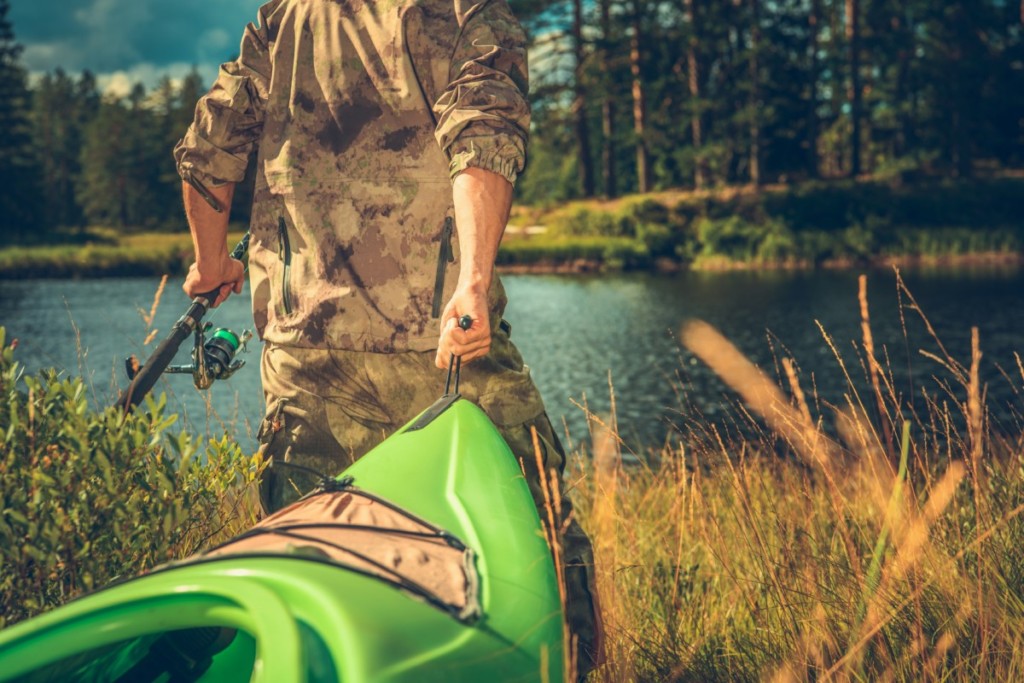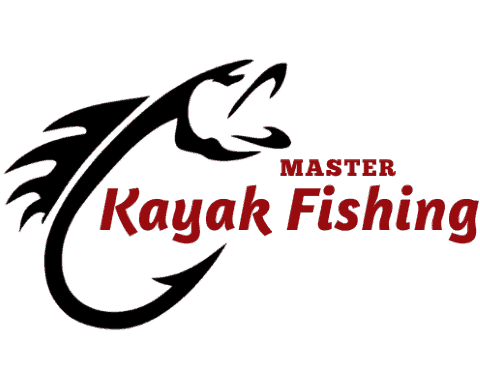
One of the trickiest things for beginning kayak fisherman is not the fishing itself, but being able to handle the kayak. It’s most evident when watching people launch and land their kayaks. Dunking your fully rigged fishing kayak upon launching is a bummer because you risk losing your gear. So let’s learn how to launch a fishing kayak properly.
To launch your Kayak in calm water, bring the boat parallel to the shore, lower your paddle perpendicular across the front of the kayak for support and slowly sit into the kayak with legs perpendicular to the boat. Then turn your body fully into the kayak, push off with paddle and your all set.
Now that works well in calm lakes and protected ocean coves, but a different method would need to be used if launching in the surf, a dock, boat ramp or rocky shoreline. Before even launching though, we have to consider our fishing setup on our kayak to ensure a smooth launch.
Setting Up Your Fishing Kayak For a Smooth Launch
Before we even launch our kayak in the water, we have to get it all set up with our gear. Between coolers, extra rods, fish finders, cameras, etc. it’s little wonder we find room for ourselves on these boats. It’s important we set them up in an efficient way.
I have two rod holders just behind my seat and one deck mounted rod holder practically in my lap. I regularly keep a rod in the holder placed in front of me, but it is totally in my way when I am trying to launch.
Upon launch, I put one rod in the rear flush mounted holder just behind my seat on the side opposite the one I mount my kayak on. All remaining roads will go in the extra rod holders located on my milk crate storage in the rear compartment of my kayak. Completely out of the way upon launch.
The anchor normally gets placed into the other flush-mounted rod holder behind my seat. It fits low into the holder so it doesn’t really get into my way there. My fishing net will be stored in a rod holder located on my milk crate storage box.
If I have a deck mounted fish finder or camera holder, I make sure I mount it on the side opposite to the one I like to mount my kayak on. I generally like to get into my kayak from the left side, so I’ll locate any potential obstacles all on the right side of the kayak.
Now we have our kayak pretty much oriented for easy launching and landing. With just a few tricks you’ll be launching your kayak like a pro in any conditions.
Launching Your Fishing Kayak in the Surf
Launching your kayak from a beach filled with surf is probably the trickiest launch you might have to face. I’ve been kayaking in the ocean for over 25 years, many of them spent catching waves with my kayak. There are a few tricks you need to know that can get you past the breakers every time.
The most important thing to do is to observe the conditions. How big are the waves? How often are the sets coming in? Is there a section of the beach where the waves might be smaller? Consider these factors before you even think of launching. If the waves are too big, consider launching somewhere else or not at all that day.
Once you have a good take on the conditions and all of your gear is ready, then you are ready to launch. With a beach launch, you’re going to get wet. There is no way around it. I like to lead my kayak into the water up to a little below waist high, keeping the nose perpendicular to the waves.
as you are trying to break through the surf zone, you want to keep the nose perpendicular to the waves at all times.
The moment your kayak is turned parallel to the wave is the moment you capsize.
Keep a close eye on the sets. Once the last set breaks, you will mount your kayak by laying your paddle perpendicular across the front of the boat and use it as support as you hop into the kayak butt first with your legs hanging off the side, quickly bring your legs around and into their footholds of the kayak and begin paddling out.
I like to paddle hard and strong through the surf zone. Hesitation is your worst enemy. As a wave approaches give your kayak some good hard strokes (making sure you are perpendicular to the wave) and just before impact, lean back, lift your paddle overhead and feel your kayak lift over and thru the wave.
Correction with the paddle may need to happen at any time as the wave may have pushed the nose of the kayak away from perpendicular. Course correct and do the same with the next wave and so on until you are through the surf zone.
Landing your kayak back through the surf zone after a day fishing is just as tricky, but similar to how you launched.
Before getting into the surf zone, hang back and make sure your gear is stowed and secure. If you have rod leashes, make sure they’re connected.
Watch the waves. Wait for a lull in the sets and watch for any section of the beach where the waves might be smaller. After the last wave of the set, paddle as hard as you can towards shore, but keep a constant eye over your shoulder. A wave may pop up behind you that you may want to consider catching or out running, depending on how far or close you are to it.
If you are in a better position to catch the wave before it breaks, try matching the speed of the wave and as you feel it take hold, give a good hard stroke with your paddle. Lean back and plan on using your paddle as a rudder on the left side if you veer towards the right and vice versa if veering towards the left.
If the wave has already broken and you have a wall of whitewater heading your way, paddle as fast as you can towards shore and try matching the speed of the wave so that it can pick you up and take you the rest of the way towards shore, using the paddle as a rudder to keep you perpendicular to the wave.
Launching through a surf zone can be tricky, but once you get the little nuances, you may find it one of the most fun things you’ll ever do.
Launching Your Fishing Kayak From a Dock
Launching from a high spot such as a dock or small pier can be a bit tricky as well but can be mastered.
First place your fishing kayak parallel to the dock or pier and your kayak paddle rests halfway on the dock, halfway in the air over the front of your kayak. Sit down on the edge of the dock oriented in a position as if you were sitting in the kayak. Place one leg into the kayak to keep it steady. Lower your other leg into the kayak and turn your body onto your belly, using the dock/pier as your main support still. Slowly lower yourself into the kayak, using the dock/pier as support and then sit down. Grab your paddle, push off and you’re ready to fish!
As you return to the dock/pier upon completion of your day, the method for getting out of your kayak is the same as getting in. Put your paddle down onto the dock, begin to lift yourself up until you are standing in your kayak, but supporting yourself by the dock. Climb up to the dock and welcome your return to dry land.
Launching Your Fishing Kayak From a Boat Ramp
Launching from a boat ramp is the same as launching from calm water but with a few important pieces of etiquette to keep in mind.
When first pulling up to a boat ramp, you do not want to pull in the dead center of the boat ramp all the way to the water. Be courteous. Pull to the side, unload your kayak, get it geared up, park your car and then launch.
It’s the right thing to do. Surefire way not to make friends in the fishing community is to hog up a boat ramp. Just don’t do it.
To launch, bring the boat parallel to the shore, lower your paddle perpendicular across the front of the kayak for support and slowly sit into the kayak with legs perpendicular to the boat. Then turn your body fully into the kayak, push off with paddle and your all set.
Upon return, approach the shoreline from a 45-degree angle. As you get a few feet from shore, give a hard steer on the waterside of the kayak to bring it parallel to shore. Using your paddle for support, bring both legs over to the shore side of the kayak and lift yourself to a standing position.
Launching Your Fishing Kayak From a Rocky Shoreline
Launching a kayak from a rocky shoreline is very much like launching from a high dock or pier. If this rocky shoreline is in the ocean you may have to factor in the rise and fall of the swells, otherwise, the process is the same.
First off, I like to secure my paddle on my kayak when launching from rocks due to the uneven nature of the environment. It’s easy for your paddle to just slide off the rocks and into the water. Just secure it to the kayak so you don’t have to worry about it.
Set your kayak as close to the rocks as possible, parallel to the shore. Sit down on your butt, reach one leg into the kayak and then as you reach to get your other leg into the kayak, twist your body so that you are on your belly supported by the rocky shoreline and slowly lower yourself into your kayak. Grab your paddle and go.
The process is the opposite upon return.
Launching Mistakes
A couple of mistakes not to make when launching your kayak. Knowing about them will protect yourself from looking like a kook, or worse, getting injured.
Some folks intuitively place their kayak perpendicular to shore and then try walking on the deck of the kayak to get to the seat. This is like walking a tightrope. I have seen many people faceplant when trying out this move. Don’t do it.
Another blunder I have seen is trying to sit into the kayak in water that is too shallow. Once you sit, your weight has you resting on the bottom and it’s almost impossible to move. Most people try to shimmy to get into deeper water, but sometimes that shimmy will tip you right over. Make sure your kayak is in deep enough water before getting in.
Fishing from a kayak is an amazing experience. Nothing can beat a day out on the open water. Just yourself and the elements. Now you have a few tips that will get you off to a great launch. Hope the fish bite for you as well. Happy Fishing!!
